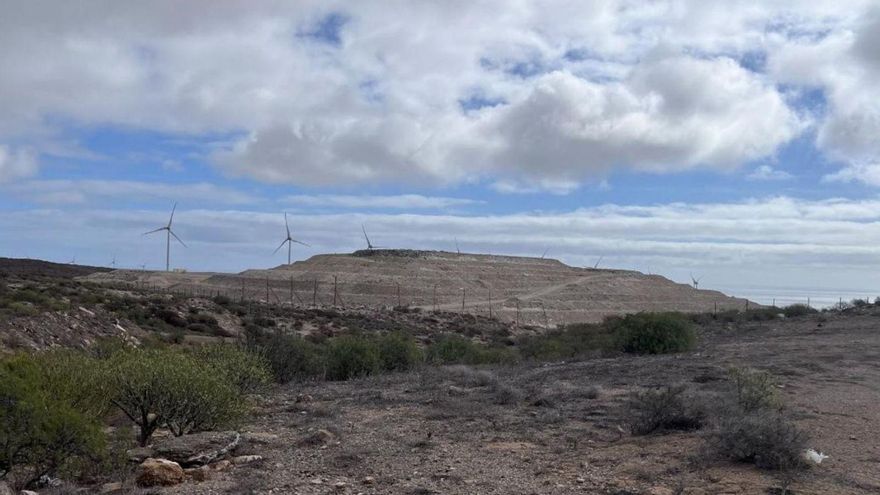In the early hours of 12 December 1958, from the beach at La Tejita in El Médano, beneath the imposing silhouette of Montaña Roja, a remarkable chapter in aviation history unfolded. The balloon Pequeño Mundo, a 14-metre diameter sphere, ascended with four British crew members on board, aiming to cross the Atlantic.
The anticipation across Tenerife was immense. Residents from all corners of the island and local authorities gathered to witness the preparations, inflation, and departure of the vessel.
The then Mayor of Granadilla de Abona, Evaristo Gómez, bid farewell to the adventurers with words that captured the community’s sentiments: “The place of El Médano now resonates universally, and its merit is due to the names of four heroic aeronauts: Rosemary Mudie, Colin Mudie, Arnold Beaupres Eiloart, and Timothy Eiloart. Have a good journey and best of luck, from the heart!”
Pequeño Mundo is one of those episodes in the island’s history that, given the scarcity of documents and its weak presence in oral memory, has left little trace and today remains almost forgotten.
However, the official chronicler of Granadilla de Abona, Emiliano Guillén Rodríguez, highlights its significance and positions it as the historic event it truly was for the community.
“The municipality has taken its place in the history of aviation. This balloon was the first to prove that this type of craft could cross the Atlantic. At that time, aviation was not very developed. From Magellan to Pequeño Mundo: these are two highly significant events for navigation that converge in Granadilla.”
OFFERINGS AND IMPACT
The preparations lasted several days, even featuring unsuccessful departure attempts due to the region’s shifting winds. Local residents enthusiastically contributed, providing food such as tomatoes and bananas, and materials to support the expedition. “Due to the weight limitations, the majority of the items gifted could not be taken,” the chronicler recalls.
The Franco regime also understood how to leverage the significance of the event. According to Guillén, “The country was interested in promoting itself to the world, and publicising El Médano was important,” as the coastal enclave began to emerge as a tourist destination.
The event was covered by El Nodo, Radio Club Tenerife, Radio Juventud de Canarias, and Radio Televisión Española.
The four aeronauts, of British origin, had extensive experience in such adventures: “One of the pilots had been the first to cross the Atlantic in a small boat called the Supradino. They firmly believed they could cross the Atlantic riding the winds.”
THE ADVENTURE BEGINS
After departing from El Médano, period accounts indicate that the balloon stayed aloft for three days, covering about 900 miles of the planned 3,000. However, a malfunction in the radio system and adverse weather conditions forced it to descend into the ocean at some point during the journey. From then on, the aeronauts converted the basket into an improvised vessel with mast and sail.
One of the crew members later recounted the decisive moment:
“We had become makeshift sailors. We still had sight of the balloon’s envelope, which, like an arrow, soared into the sky as it detached from our craft. We watched it for a moment before it disappeared forever among the clouds. At that point, we were unaware we would be sailing for three weeks, during which time our lives would be in constant jeopardy.”
WATER RATIONING
The chronicler Emiliano Guillén clarifies: “It cannot be said that they crossed the entire Atlantic. There was a period of information darkness, safeguarded by the English press. According to sources, the experience was not easy for them, but they were eventually rescued safe and sound.”
During the maritime journey, they advanced at about six kilometres per hour. They faced no serious food issues but had to ration water. On 21 December, Colin Mudie noted in his journal: “We only have 1,852 kilometres left to cover. We have already completed three-quarters of the distance.”
Finally, on 5 January 1959, after weeks of uncertainty, the Pequeño Mundo reached the Caribbean, specifically Barbados. They were spotted by the fishing vessel New Providence, which towed them the last four miles to the shore.
Although they did not complete the flight across the entire Atlantic, the four aeronauts demonstrated that the crossing was possible and left an indelible mark on local and global history.
Beyond the technical odyssey and the risks faced by the four British aeronauts, the launch of Pequeño Mundo from La Tejita left an enduring impression in the collective memory of Granadilla de Abona.














